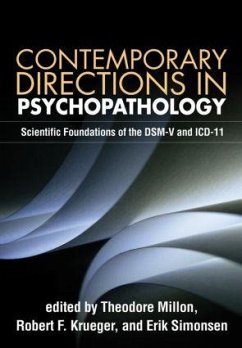Contemporary Directions in Psychopathology
Scientific Foundations of the Dsm-V and ICD-11
Herausgeber: Millon, Theodore; Simonsen, Erik; Krueger, Robert F
Contemporary Directions in Psychopathology
Scientific Foundations of the Dsm-V and ICD-11
Herausgeber: Millon, Theodore; Simonsen, Erik; Krueger, Robert F
- Gebundenes Buch
- Merkliste
- Auf die Merkliste
- Bewerten Bewerten
- Teilen
- Produkt teilen
- Produkterinnerung
- Produkterinnerung
This forward-thinking volume grapples with critical questions surrounding the mechanisms underlying mental disorders and the systems used for classifying them. Edited and written by leading international authorities, many of whom are actively involved with the development of DSM-V and ICD-11, the book integrates biological and psychosocial perspectives. It provides balanced analyses of such issues as the role of social context and culture in psychopathology and the pros and cons of categorical versus dimensional approaches to diagnosis. Cutting-edge diagnostic instruments and research methods…mehr
Andere Kunden interessierten sich auch für
![New Directions in Sex Therapy New Directions in Sex Therapy]() New Directions in Sex Therapy139,99 €
New Directions in Sex Therapy139,99 €![Vulnerability to Psychopathology Vulnerability to Psychopathology]() Vulnerability to Psychopathology111,99 €
Vulnerability to Psychopathology111,99 €![New Directions in Sex Therapy New Directions in Sex Therapy]() New Directions in Sex Therapy176,99 €
New Directions in Sex Therapy176,99 €![Distress Tolerance Distress Tolerance]() Distress Tolerance60,99 €
Distress Tolerance60,99 €![Directions in Geography Directions in Geography]() Directions in Geography139,99 €
Directions in Geography139,99 €![New Directions in Treatment, Education, and Outreach for Mental Health and Addiction New Directions in Treatment, Education, and Outreach for Mental Health and Addiction]() New Directions in Treatment, Education, and Outreach for Mental Health and Addiction60,99 €
New Directions in Treatment, Education, and Outreach for Mental Health and Addiction60,99 €![New Directions in Treatment, Education, and Outreach for Mental Health and Addiction New Directions in Treatment, Education, and Outreach for Mental Health and Addiction]() New Directions in Treatment, Education, and Outreach for Mental Health and Addiction82,99 €
New Directions in Treatment, Education, and Outreach for Mental Health and Addiction82,99 €-
-
-
This forward-thinking volume grapples with critical questions surrounding the mechanisms underlying mental disorders and the systems used for classifying them. Edited and written by leading international authorities, many of whom are actively involved with the development of DSM-V and ICD-11, the book integrates biological and psychosocial perspectives. It provides balanced analyses of such issues as the role of social context and culture in psychopathology and the pros and cons of categorical versus dimensional approaches to diagnosis. Cutting-edge diagnostic instruments and research methods are reviewed. Throughout, contributors highlight the implications of current theoretical and empirical advances for understanding real-world clinical problems and developing more effective treatments.
Hinweis: Dieser Artikel kann nur an eine deutsche Lieferadresse ausgeliefert werden.
Hinweis: Dieser Artikel kann nur an eine deutsche Lieferadresse ausgeliefert werden.
Produktdetails
- Produktdetails
- Verlag: Guilford Publications
- Seitenzahl: 622
- Erscheinungstermin: 19. März 2010
- Englisch
- Abmessung: 263mm x 187mm x 42mm
- Gewicht: 1311g
- ISBN-13: 9781606235324
- ISBN-10: 160623532X
- Artikelnr.: 28897623
- Herstellerkennzeichnung
- Libri GmbH
- Europaallee 1
- 36244 Bad Hersfeld
- gpsr@libri.de
- Verlag: Guilford Publications
- Seitenzahl: 622
- Erscheinungstermin: 19. März 2010
- Englisch
- Abmessung: 263mm x 187mm x 42mm
- Gewicht: 1311g
- ISBN-13: 9781606235324
- ISBN-10: 160623532X
- Artikelnr.: 28897623
- Herstellerkennzeichnung
- Libri GmbH
- Europaallee 1
- 36244 Bad Hersfeld
- gpsr@libri.de
Theodore Millon, PhD, DSc, until his death in 2014, was Dean and Scientific Director of the Institute for Advanced Studies in Personology and Psychopathology. He was Founding Editor of the Journal of Personality Disorders and inaugural president of the International Society for the Study of Personality Disorders. Dr. Millon held full professorial appointments at Harvard Medical School, the University of Illinois, and the University of Miami. A prolific author, he wrote or edited more than 30 books on theory, assessment, and therapy, as well as more than 200 articles and book chapters, and developed the widely used Millon Clinical Multiaxial Inventory (MCMI). He was a recipient of the Gold Medal for Life Achievement in the Application of Psychology from the American Psychological Foundation, which annually presents the Theodore Millon Award in Personality Psychology in his honor. Robert F. Krueger, PhD, is Distinguished McKnight University Professor at the University of Minnesota. His research interests lie at the intersection of psychopathology, personality, psychometrics, behavior genetics, and physical health. Dr. Krueger is the recipient of awards including the Hoch Award from the American Psychopathological Association. He is coeditor of the Journal of Personality Disorders. Erik Simonsen PhD, MD, is Professor Emeritus in the Department of Clinical Medicine, University of Copenhagen, and former Director of the Psychiatric Research Unit of Region Zealand, Denmark. He serves on the editorial boards of the Journal of Personality Disorders and Early Intervention in Psychiatry. With Theodore Millon, Dr. Simonsen cofounded the International Society for the Study of Personality Disorders, for which he served as General-Secretary and later as President. He is a past chair of the Section of Personality Disorders of the World Psychiatric Association. Dr. Simonsen has received numerous international awards and has published mainly on early detection, psychotherapy, assessment, and classification of first-episode psychosis and personality disorders.
I. Historical and Cultural Perspectives 1. A PrÃ(c)cis of
Psychopathological History 2. Themes in the Evolution of the 20th-Century
DSMs 3. On the Wisdom of Considering Culture and Context in Psychopathology
4. Cultural Issues in the Coordination of DSM-V and ICD-11 5. A
Sociocultural Conception of the Borderline Personality Disorder Epidemic
II. Conceptual Issues in Classification 6. Philosophical Issues in the
Classification of Psychopathology 7. Classification Considerations in
Psychopathology and Personology 8. Diagnostic Taxa as Open Concepts:
Metatheoretical and Statistical Questions about Reliability and Construct
Validity in the Grand Strategy of Nosological Revision 9. Contemplations on
Meehl (1986): The Territory, PaulâEUR(TM)s Map, and Our Progress in
Psychopathology Classification (or, the Challenge of Keeping Up with a
Beacon 30 Years Ahead of the Field) 10. Issues of Construct Validity in
Psychological Diagnoses 11. The Meaning of Comorbidity among Common Mental
Disorders 12. The Connections between Personality and Psychopathology 13.
Is It True That Mental Disorders Are So Common, and So Commonly Co-Occur?
14. Taking Disorder Seriously: A Critique of Psychiatric Criteria for
Mental Disorders from the Harmful-Dysfunction Perspective III.
Methodological Approaches to Categories, Dimensions, and Prototypes 15. On
the Substantive Grounding and Clinical Utility of Categories versus
Dimensions 16. A Short History of a Psychiatric Diagnostic Category That
Turned Out to Be a Disease 17. Concepts and Methods for Researching
Categories and Dimensions in Psychiatric Diagnosis 18. The Integration of
Categorical and Dimensional Approaches to Psychopathology 19.
Dimensionalizing Existing Personality Disorder Categories 20. An
Empirically Based Prototype Diagnostic System for DSM-V and ICD-11 21. The
Millon Personality Spectrometer: A Tool for Personality Spectrum Analyses,
Diagnoses, and Treatments IV. Innovative Theoretical and Empirical
Proposals 22. Neuroscientific Foundations of Psychopathology 23. Using
Evolutionary Principles for Deducing Normal and Abnormal Personality
Patterns 24. Biopsychosocial Models and Psychiatric Diagnosis 25.
Reactivating the Psychodynamic Approach to the Classification of
Psychopathology 26. A Life Course Approach to Psychoses: Outcome and
Cultural Variation 27. The Interpersonal Nexus of Personality and
Psychopathology 28. Reconceptualizing Autism Spectrum Disorders as
Autism-Specific Learning Disabilities and Styles 29. Describing
Relationship Patterns in DSM-V: A Preliminary Proposal 30. On the Diversity
of the Borderline Syndromes
Psychopathological History 2. Themes in the Evolution of the 20th-Century
DSMs 3. On the Wisdom of Considering Culture and Context in Psychopathology
4. Cultural Issues in the Coordination of DSM-V and ICD-11 5. A
Sociocultural Conception of the Borderline Personality Disorder Epidemic
II. Conceptual Issues in Classification 6. Philosophical Issues in the
Classification of Psychopathology 7. Classification Considerations in
Psychopathology and Personology 8. Diagnostic Taxa as Open Concepts:
Metatheoretical and Statistical Questions about Reliability and Construct
Validity in the Grand Strategy of Nosological Revision 9. Contemplations on
Meehl (1986): The Territory, PaulâEUR(TM)s Map, and Our Progress in
Psychopathology Classification (or, the Challenge of Keeping Up with a
Beacon 30 Years Ahead of the Field) 10. Issues of Construct Validity in
Psychological Diagnoses 11. The Meaning of Comorbidity among Common Mental
Disorders 12. The Connections between Personality and Psychopathology 13.
Is It True That Mental Disorders Are So Common, and So Commonly Co-Occur?
14. Taking Disorder Seriously: A Critique of Psychiatric Criteria for
Mental Disorders from the Harmful-Dysfunction Perspective III.
Methodological Approaches to Categories, Dimensions, and Prototypes 15. On
the Substantive Grounding and Clinical Utility of Categories versus
Dimensions 16. A Short History of a Psychiatric Diagnostic Category That
Turned Out to Be a Disease 17. Concepts and Methods for Researching
Categories and Dimensions in Psychiatric Diagnosis 18. The Integration of
Categorical and Dimensional Approaches to Psychopathology 19.
Dimensionalizing Existing Personality Disorder Categories 20. An
Empirically Based Prototype Diagnostic System for DSM-V and ICD-11 21. The
Millon Personality Spectrometer: A Tool for Personality Spectrum Analyses,
Diagnoses, and Treatments IV. Innovative Theoretical and Empirical
Proposals 22. Neuroscientific Foundations of Psychopathology 23. Using
Evolutionary Principles for Deducing Normal and Abnormal Personality
Patterns 24. Biopsychosocial Models and Psychiatric Diagnosis 25.
Reactivating the Psychodynamic Approach to the Classification of
Psychopathology 26. A Life Course Approach to Psychoses: Outcome and
Cultural Variation 27. The Interpersonal Nexus of Personality and
Psychopathology 28. Reconceptualizing Autism Spectrum Disorders as
Autism-Specific Learning Disabilities and Styles 29. Describing
Relationship Patterns in DSM-V: A Preliminary Proposal 30. On the Diversity
of the Borderline Syndromes
I. Historical and Cultural Perspectives 1. A PrÃ(c)cis of
Psychopathological History 2. Themes in the Evolution of the 20th-Century
DSMs 3. On the Wisdom of Considering Culture and Context in Psychopathology
4. Cultural Issues in the Coordination of DSM-V and ICD-11 5. A
Sociocultural Conception of the Borderline Personality Disorder Epidemic
II. Conceptual Issues in Classification 6. Philosophical Issues in the
Classification of Psychopathology 7. Classification Considerations in
Psychopathology and Personology 8. Diagnostic Taxa as Open Concepts:
Metatheoretical and Statistical Questions about Reliability and Construct
Validity in the Grand Strategy of Nosological Revision 9. Contemplations on
Meehl (1986): The Territory, PaulâEUR(TM)s Map, and Our Progress in
Psychopathology Classification (or, the Challenge of Keeping Up with a
Beacon 30 Years Ahead of the Field) 10. Issues of Construct Validity in
Psychological Diagnoses 11. The Meaning of Comorbidity among Common Mental
Disorders 12. The Connections between Personality and Psychopathology 13.
Is It True That Mental Disorders Are So Common, and So Commonly Co-Occur?
14. Taking Disorder Seriously: A Critique of Psychiatric Criteria for
Mental Disorders from the Harmful-Dysfunction Perspective III.
Methodological Approaches to Categories, Dimensions, and Prototypes 15. On
the Substantive Grounding and Clinical Utility of Categories versus
Dimensions 16. A Short History of a Psychiatric Diagnostic Category That
Turned Out to Be a Disease 17. Concepts and Methods for Researching
Categories and Dimensions in Psychiatric Diagnosis 18. The Integration of
Categorical and Dimensional Approaches to Psychopathology 19.
Dimensionalizing Existing Personality Disorder Categories 20. An
Empirically Based Prototype Diagnostic System for DSM-V and ICD-11 21. The
Millon Personality Spectrometer: A Tool for Personality Spectrum Analyses,
Diagnoses, and Treatments IV. Innovative Theoretical and Empirical
Proposals 22. Neuroscientific Foundations of Psychopathology 23. Using
Evolutionary Principles for Deducing Normal and Abnormal Personality
Patterns 24. Biopsychosocial Models and Psychiatric Diagnosis 25.
Reactivating the Psychodynamic Approach to the Classification of
Psychopathology 26. A Life Course Approach to Psychoses: Outcome and
Cultural Variation 27. The Interpersonal Nexus of Personality and
Psychopathology 28. Reconceptualizing Autism Spectrum Disorders as
Autism-Specific Learning Disabilities and Styles 29. Describing
Relationship Patterns in DSM-V: A Preliminary Proposal 30. On the Diversity
of the Borderline Syndromes
Psychopathological History 2. Themes in the Evolution of the 20th-Century
DSMs 3. On the Wisdom of Considering Culture and Context in Psychopathology
4. Cultural Issues in the Coordination of DSM-V and ICD-11 5. A
Sociocultural Conception of the Borderline Personality Disorder Epidemic
II. Conceptual Issues in Classification 6. Philosophical Issues in the
Classification of Psychopathology 7. Classification Considerations in
Psychopathology and Personology 8. Diagnostic Taxa as Open Concepts:
Metatheoretical and Statistical Questions about Reliability and Construct
Validity in the Grand Strategy of Nosological Revision 9. Contemplations on
Meehl (1986): The Territory, PaulâEUR(TM)s Map, and Our Progress in
Psychopathology Classification (or, the Challenge of Keeping Up with a
Beacon 30 Years Ahead of the Field) 10. Issues of Construct Validity in
Psychological Diagnoses 11. The Meaning of Comorbidity among Common Mental
Disorders 12. The Connections between Personality and Psychopathology 13.
Is It True That Mental Disorders Are So Common, and So Commonly Co-Occur?
14. Taking Disorder Seriously: A Critique of Psychiatric Criteria for
Mental Disorders from the Harmful-Dysfunction Perspective III.
Methodological Approaches to Categories, Dimensions, and Prototypes 15. On
the Substantive Grounding and Clinical Utility of Categories versus
Dimensions 16. A Short History of a Psychiatric Diagnostic Category That
Turned Out to Be a Disease 17. Concepts and Methods for Researching
Categories and Dimensions in Psychiatric Diagnosis 18. The Integration of
Categorical and Dimensional Approaches to Psychopathology 19.
Dimensionalizing Existing Personality Disorder Categories 20. An
Empirically Based Prototype Diagnostic System for DSM-V and ICD-11 21. The
Millon Personality Spectrometer: A Tool for Personality Spectrum Analyses,
Diagnoses, and Treatments IV. Innovative Theoretical and Empirical
Proposals 22. Neuroscientific Foundations of Psychopathology 23. Using
Evolutionary Principles for Deducing Normal and Abnormal Personality
Patterns 24. Biopsychosocial Models and Psychiatric Diagnosis 25.
Reactivating the Psychodynamic Approach to the Classification of
Psychopathology 26. A Life Course Approach to Psychoses: Outcome and
Cultural Variation 27. The Interpersonal Nexus of Personality and
Psychopathology 28. Reconceptualizing Autism Spectrum Disorders as
Autism-Specific Learning Disabilities and Styles 29. Describing
Relationship Patterns in DSM-V: A Preliminary Proposal 30. On the Diversity
of the Borderline Syndromes








